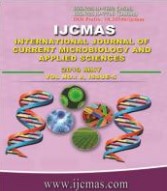


 National Academy of Agricultural Sciences (NAAS)
National Academy of Agricultural Sciences (NAAS)

|
PRINT ISSN : 2319-7692
Online ISSN : 2319-7706 Issues : 12 per year Publisher : Excellent Publishers Email : editorijcmas@gmail.com / submit@ijcmas.com Editor-in-chief: Dr.M.Prakash Index Copernicus ICV 2018: 95.39 NAAS RATING 2020: 5.38 |
Survey was undertaken to assess honey production system, identify major beekeeping constraints and determine the association of potential risk factors with occurrence of honeybee diseases, predators and pests at Ganderbal district of Kashmir during summer 2018. Questionnaire survey and laboratory diagnostic methods were employed. A total of 50 beekeepers were included in the questionnaire survey and were interviewed through questionnaire survey, 64.5% had knowledge about honey bee diseases and pests. A total of 384 honey bee colonies were randomly examined for the presence of honeybee external parasites and pathogenic diseases. Regarding honeybee pests and predators, the rank index confirmed that the most important pests and predators affecting Traditional honeybee colonies were wax moth (18.2%), Bee lice (12.3%), hive Beetles (7.2%), and bee eater birds (7%). The major constraints affecting beekeeping development in the study areas in decreasing order were pests and predators (17.5%), high cost of modern hives and accessories (15.5%), agro-chemical application (14.3%), honey bee diseases (11.9%), poor management (10.5%), winter mortality of honeybee colony (10.5%), shortage of bee forage (10.2%) and absconding (9.6%). The study demonstrated that honey productions in the study area are hampered by several constraints and pests. Therefore, improvement of honey bee hive management, disease and pests prevention are paramount important.
 |
 |
 |
 |
 |